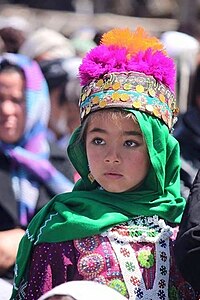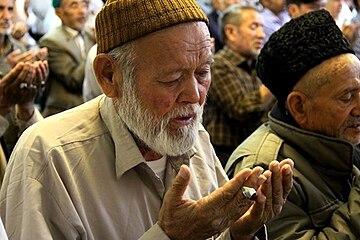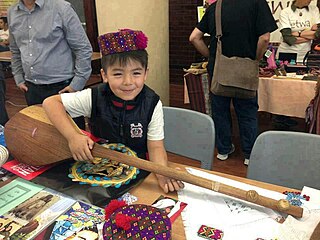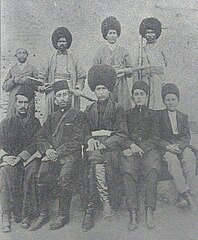Hazaras
 Hazara schoolgirls in Bamyan province | |
| Total population | |
|---|---|
| c. 12 million | |
| Regions with significant populations | |
| 6,000,000[1][2] | |
| 2,000,000[3][4][5] | |
| 500,000[6] | |
| 130,000[7] | |
| 41,766[8] | |
| 26,000[9] | |
| 10,300[10] | |
| 3,800[11] | |
| Languages | |
| Religion | |
| [12][13] | |
| Related ethnic groups | |
| [14][15][16][17][18][19][20][21] | |
The Hazaras (Persian: هزاره, romanized: Həzārə; Hazaragi: آزره, romanized: Āzrə) are an ethnic group and a principal component of the population of Afghanistan, native to Afghanistan, Pakistan, and Iran. They are one of the largest ethnic groups in Afghanistan and primarily residing in the Hazaristan region in central Afghanistan, as well as a significant minority groups mainly in Quetta, Pakistan and Mashhad, Iran. They speak the Dari and Hazaragi dialects of Persian. Dari, also known as Dari Persian, is one of two official languages of Afghanistan besides Pashto.[22][23][24][25][26][27][5][6][28][29][30][31]
Hazaras are considered to be one of the most persecuted groups in Afghanistan.[32] More than half of the Hazara population was massacred by the Emirate of Afghanistan between 1888 and 1893,[33] and their persecution has occurred various times across previous decades.[34]
Etymology
The etymology of the word "Hazara" remains disputed, but some have differing opinions on the term.
- Babur, the founder of the Mughal Empire in the early 16th century, recorded the name "Hazara" in the Baburnama and several times referred to the Hazaras as "Turkoman Hazaras".[35][36]
- Historian Abdul Hai Habibi considers the word "Hazara" (həzārə هزاره) to be very old, and it is derived from "Hazala" (həzālə هزاله), which has changed to "Hazara" over time and has meant "good-hearted".[37][38]
- Some believe that in ancient times, because of the Hazara people's high population, they were called "Hazara" (həzārə هزاره), which the name "Hazara" derives from the Persian word "Hazar" (həzār هزار) meaning "thousand" and it is a metaphor for a population of over thousand.[39]
- It is said that the name "Hazara" (həzārə هزاره) derives from the Persian word "Hazar" (həzār هزار) meaning "thousand". It may be the translation of the Mongolic word (mingghan), a military unit of 1,000 soldiers at the time of Genghis Khan.[40][41][42] The term could have been substituted for the Mongolic word and stands for the group of people,[43] while the Hazara people in their native language call themselves "Azra" (āzrə آزره) or (əzrə ازره).[44]
Origin

Despite being one of the principal population elements of Afghanistan,[30] the origins of the Hazara people have not been fully reconstructed. However, due to genetic and linguistic analysis, Hazaras are described as an ethnically mixed ethnic group[31] with Hazaras sharing varying degrees of ancestry with contemporary Turkic, Mongolic, and Iranic populations.[31][45][19][20][46][21][17][18] Additionally, overall Hazaras share a common racial structure and physical appearance with the Turkic people of Central Asia.[21][47]
Over the course of centuries, invading Mongol (Turco-Mongol) and Turkic invaders, notably, the Qara'unas, the Chagatai Turco-Mongols, the Ilkhanate, and the Timurids, merged with the local indigenous Turkic and Iranic populations.[48] While academics agree that Hazaras are ultimately the result of a combination of several Turkic, Mongolic, and Iranic tribes, there is a dispute by some on what groups played the largest roles in this combination.[citation needed]
According to historian Lutfi Temirkhanov, the Mongolian detachments left in Afghanistan by Genghis Khan or his successors became the starting layer, the basis of the Hazara ethnogenesis.[17] The participation of the Mongols in the ethnogenesis of the Hazaras is evidenced by linguistic data, historical sources, data on toponymy,[49] as well as works on population genetics.[50] Such scholars as Vasily Bartold,[51] Ármin Vámbéry,[52] Vadim Masson, Vadim Romodin,[53] Ilya Petrushevsky,[54] Allah Rakha, Fatima, Min-Sheng Peng, Atif Adan, Rui Bi, Memona Yasmin, Yong-Gang Yao wrote about the historical use of the Mongolian language by the Hazaras.[55]
Genetics
Genetically, the Hazara combine varying amounts of West Eurasian and East Eurasian derived components. Genetic data shows that the Hazaras of Afghanistan cluster closely with the Uzbek population of the country, while both groups are at a notable distance from Afghanistan's Tajik and Pashtun populations.[56][21] There is evidence for both paternal and maternal relations to Turkic peoples, Mongolic peoples, and Iranic peoples.[57]
The frequency of ancestry components among the Hazaras vary according to tribal affiliation. They display high genetic affinity to present-day Turkic populations of Central Asia and East Asia. One analysis argues that the Hazaras are a Central Asian people, closely related to the Turkic populations of Central Asia, rather than Mongolians and East Asians or Indo-Iranians. In terms of their overall genetic makeup, around 49% of the Hazaras average gene pool is derived from East Asian-like sources, around 48% is derived from European-like sources, and around 0,17%, 0,47%, and 2,30% is derived from African, Oceanian, and Amerindian-like sources respectively. The Hazara can also be modeled as having 57,8% Mongolian-related ancestry, with the remainder (42,2%) being derived from Iranian-like sources. The Hazaras genetic makeup is most similar to the Turkic Uzbek, Uyghur, Kazakh, and Kyrgyz populations.[58][59][60][61]
Paternal haplogroups
The most common paternal DNA haplogroups of Hazaras from Afghanistan are the West Eurasian R1a and East Eurasian C-M217 clades, followed by West Eurasian J2-M172 and L-M20. Some Hazaras were also found to belong to the haplogroup R1a1a-M17, E1b1b1-M35, L-M20 and H-M69, which are shared with Tajiks, Pashtuns as well as Indian populations. One individual with haplogroup B-M60, normally found in Eastern Africa, was found as well.[62][63]
Pakistani Hazara harbored high frequency of haplogroup C-M217 at c. 40% (10/25) and Haplogroup R1b at c. 32% (8/25). A relatively high frequency of R1b was also found in Eastern Russian Tatars and Bashkirs. All three groups are thought to be associated with the Golden Horde.[64] Haplogroup C-M217, also known as C2, is the most frequent haplogroup in Kazakh and Mongol populations.[65]
Maternal haplogroups
The Hazara share c. 35% maternal haplogroups with contemporary East Asian populations, while c. 65% is shared with West Eurasian populations.[66] The Hazaras as a whole have mostly West Eurasian mtDNA.[67][68][69]
History
The first mention of Hazaras is made by Babur in the early 16th century and later by the court historians of Shah Abbas of the Safavid dynasty. It is reported that they embraced Shia Islam between the end of the 16th and the beginning of the 17th century, during the Safavid periods.[70][71] Hazara men, along with those of other ethnic groups, were recruited to the army of Ahmad Shah Durrani in the 18th century.[72]
19th century
During the second reign of Dost Mohammad Khan in the 19th century, Hazaras from Hazarajat began to be taxed for the first time. However, for the most part, they still managed to keep their regional autonomy until the 1892 Battle of Uruzgan[73] and subsequent subjugation of Abdur Rahman Khan began in the late 19th century.[74]
When the Treaty of Gandomak was signed and the Second Anglo-Afghan War ended in 1880, Abdur Rahman Khan set out a goal to bring Hazaristan, Turkistan and Kafiristan under his control. He launched several campaigns in Hazarajat due to resistance from the Hazaras in which his forces committed atrocities. The southern part of Hazarajat was spared as they accepted his rule, while the other parts of Hazarajat rejected Abdur Rahman and instead supported his uncle, Sher Ali Khan. In response to this Abdur Rahman waged a war against tribal leaders who rejected his policies and rule.[70] This is known as the Hazara Uprisings.
These campaigns had a catastrophic impact on the demographics of Hazaras causing over sixty percent of the total Hazara population to be massacred with some being displaced and exiled from their own lands. The Hazara lands was distributed among loyalist villagers of nearby non-Hazaras. The repression after the uprising has been called genocide or ethnic cleansing in the history of modern Afghanistan.[75][76][77]
After these massacres, Abdul Rahman Khan forced many Hazara families from the Hazara areas of Uruzgan and other parts of Hazarajat to leave their hometowns and ancestral lands. causing some many Hazaras fled to neighboring countries such as Central Asia, Iran, British India, Iraq and Syria. Those Hazaras living in the northern Hindu Kush went to Tsarist Russia, mostly in the southern cities of Russia, and some of them went to Iran. Many Hazaras living in the Tsarist Russian regions lost their language, accent and ethnic identity over time due to the similarities between the racial building and the physical appearance of the people of those regions, and they settled and gravitated among them. These fleeing Hazaras settled in previous Tsarist Russia regions, including Uzbekistan, Tajikistan, Turkmenistan, Kazakhstan and Dagestan. But the Hazaras in northwestern Afghanistan migrated to Iran and settled in neighborhoods in and around Mashhad. These Hazaras later became known as Khawari or Barbari. Another part of Hazaras from the southeast of the Hazara regions of Afghanistan has moved to British India, which resides in Quetta, present-day Pakistan. One of the most famous political and military figures of these Hazaras is Muhammad Musa Khan, who held the general's military rank in Pakistani system. Another group has settled in Syria, Iraq and British India. These Hazara people who migrated to Pakistan, Iran, Syria and Iraq were unable to settle with the people of these areas because of the differences in physical appearance, so they have not lost their language, culture and ethnic identity.[78]
20th and 21st century
This section's tone or style may not reflect the encyclopedic tone used on Wikipedia. (October 2018) |

In 1901, Habibullah Khan, Abdur Rahman's eldest son and successor granted amnesty to Hazaras and asked them to return who were exiled by his predecessor. But few of them returned and settled in Afghan Turkestan and Balkh province because they had lost their previous lands. Hazara continued to face social, economic and political discrimination through most of the 20th century. In 1933 Mohammed Nadir Shah the King of Afghanistan was assassinated by Abdul Khaliq Hazara, a school student. The Afghan government captured and executed him later, along with several of his family members.[79]
Mistrust of the central government by the Hazaras and local uprisings continued. In particular, from 1945 to 1946, during Zahir Shah's rule, a revolt took place by the leadership of Ibrahim Khan most known as "Ibrahim Gawsawar" against new taxes that were exclusively imposed on Hazaras. The Kuchis meanwhile not only were exempted from taxes but also received allowances from the Afghan government.[70] The angry rebels began capturing and killing government officials. In response, the central government sent a force to subdue the region and later removed the taxes.[citation needed]


The repressive policies[clarification needed] of the People's Democratic Party of Afghanistan (PDPA) after the Saur Revolution in 1978 caused uprisings throughout the country. Fearing Iranian influence, the Hazaras were particularly persecuted. President Hafizullah Amin published in October 1979 a list of 12,000 victims of the Taraki government. Among them were 7,000 Hazaras who were shot in the notorious Pul-e-Charkhi prison.[80]
During the Soviet-Afghan War, the Hazarajat region did not see as much heavy fighting as other regions of Afghanistan. Most of the Hazara mujahideen fought the Soviets in the regions which were on the periphery of the Hazarajat region. There was a division between the Tanzeem Nasle Nau Hazara, a party based in Quetta, of Hazara nationalists and secular intellectuals, and the Islamist parties in Hazarajat.[70] By 1979, the Hazara-Islamist groups had already liberated Hazarajat from the central Soviet-backed Afghan government and later took entire control of Hazarajat away from the secularists. By 1984, the Islamist dominance of Hazarajat was complete. As the Soviets withdrew in 1989, the Islamist groups felt the need to broaden their political appeal and turned their focus to Hazara nationalism.[70] This led to the establishment of the Hizbe-Wahdat, an alliance of all the Hazara resistance groups (except the Harakat-e Islami). In 1992 with the fall of Kabul, the Harakat-e Islami took sides with Burhanuddin Rabbani's government while the Hizbe-Wahdat took sides with the opposition. The Hizbe-Wahdat was eventually forced out of Kabul in 1995 when the Taliban movement captured and killed their leader Abdul Ali Mazari. With the Taliban's capture of Kabul in 1996, all the Hazara groups united with the new Northern Alliance against the common new enemy. However, despite fierce resistance Hazarajat fell to the Taliban in 1998. The Taliban had Hazarajat isolated from the rest of the world going as far as not allowing the United Nations to deliver food to the provinces of Bamyan, Ghor, Maidan Wardak and Daykundi.[81]
In 1997, a revolt broke out among Hazaras in Mazar-e Sharif when they refused to be disarmed by the Taliban; 600 Taliban were killed in subsequent fighting.[82] In retaliation, the genocidal policies of Abdur Rahman Khan's era was adopted by the Taliban. In 1998, six thousand Hazaras were killed in the north; the intention was ethnic cleansing of Hazaras.[83] In March 2001, the two giant Buddhas of Bamiyan, were also destroyed even though there was a lot of condemnation.[84]

Hazaras have also played a significant role in the creation of Pakistan. One such Hazara was Qazi Muhammad Isa of the Sheikh Ali tribe, who had been close friends with Muhammad Ali Jinnah, having met each other for the first time while they were studying in London. He had been the first from his native province of Balochistan to obtain a Bar-at-Law degree and had helped set up the All-India Muslim League in Balochistan.[85][86]
Though Hazaras played a role in the anti-Soviet movement, other Hazaras participated in the new communist government, which actively courted Afghan minorities. Sultan Ali Kishtmand, a Hazara, served as prime minister of Afghanistan from 1981 to 1990 (with one brief interruption in 1988).[87] The Ismaili Hazara of Baghlan Province likewise supported the communists, and their pir (religious leader) Jaffar Naderi led a pro-Communist militia in the region.[88]
During the years that followed, Hazara suffered severe oppression, and many ethnic massacres, genocides, and pogroms were carried out by the predominantly ethnic Pashtun Taliban and are documented by such groups as the Human Rights Watch.[89]
Following the September 11, 2001 attacks in the United States, American and Coalition forces invaded Afghanistan. After the fall of the Taliban many Hazaras became important figures in Afghanistan.[90] Hazara have also pursued higher education, enrolled in the army, and many have top government positions.[91] For example, Some Vice Presidents, ministers and governors were Hazara, including Karim Khalili, Sarwar Danish, Sima Samar, Muhammad Mohaqiq, Habiba Sarābi, Abdul Haq Shafaq, Sayed Anwar Rahmati, Qurban Ali Urozgani, Muhammad Arif Shah Jahan, Mahmoud Baligh, Mohammad Eqbal Munib and Mohammad Asim Asim. The mayor of Nili, Daykundi was Azra Jafari, who became the first female mayor in Afghanistan. Some other notable Hazaras include Sultan Ali Keshtmand, Abdul Wahed Sarābi, Akram Yari, Ghulam Ali Wahdat, Sayed Mustafa Kazemi, Ghulam Husain Naseri, Abbas Noyan, Daoud Naji, Abbas Ibrahim Zada, Ramazan Bashardost, Ahmad Shah Ramazan, Ahmad Behzad, Nasrullah Sadiqi Zada Nili, Fahim Hashimy, Maryam Monsef and others.[92]
Although Afghanistan has been historically one of the poorest countries in the world, the Hazarajat region has been kept less developed by past governments. Since the ousting of the Taliban in late 2001, billions of dollars poured into Afghanistan for reconstruction and several large-scale reconstruction projects took place in Afghanistan from August 2012. For example, there have been more than 5000 kilometers of road pavement completed across Afghanistan, of which little was done in central Afghanistan (Hazarajat). On the other hand, the Band-e Amir in Bamyan Province became the first national park in Afghanistan. A road from Kabul to Bamyan was also built, along with new police stations, government institutions, hospitals and schools in the provinces of Bamyan, Daykundi and others mostly Hazara-populated provinces. The first ski resort in Afghanistan was also established in Bamyan Province.[93][94]
Discrimination indicates that Kuchis (Pashtun nomads who have historically been migrating from region to region depending on the season) are allowed to use Hazarajat pastures during the summer season. It is believed that allowing the Kuchis to use some of the grazing lands in Hazarajat began during the rule of Abdur Rahman Khan.[95] Living in mountainous Hazarajat, where little farmland exists, Hazara people rely on these pasture lands for their livelihood during the long and harsh winters. In 2007 some Kuchi nomads entered into parts of Hazarajat to graze their livestock, and when the local Hazara resisted, a clash took place and several people on both sides died using assault rifles. Such events continue to occur, even after the central government was forced to intervene, including President Hamid Karzai. In late July 2012, a Hazara police commander in Uruzgan province reportedly rounded up and killed 9 Pashtun civilians in revenge for the death of two local Hazara. The matter is being investigated by the Afghan government.[95]
The drive by President Hamid Karzai after the Peace Jirga to strike a deal with Taliban leaders caused deep unease in Afghanistan's minority communities, who fought the Taliban the longest and suffered the most during their rule. The leaders of the Tajik, Uzbek and Hazara communities, vowed to resist any return of the Taliban to power, referring to the large-scale massacres of Hazara civilians during the Taliban period.[96]
Following the fall of Kabul to the Taliban in 2021, which ended the war in Afghanistan, concerns were raised as to whether the Taliban would reimpose the persecution of Hazaras as in the 1990s. An academic at Melbourne's La Trobe University said that "The Hazaras are very fearful that the Taliban will likely be reinstating the policies of the 1990s" despite Taliban reassurances that they will not revert to the bad old ways of the 1990s.[97][98]
-
Karim Khalili, former 2nd Vice President of Afghanistan (with turban) is standing next to Mohammed Fahim, George W. Bush, facing Hamid Karzai.
-
Habiba Sarābi is a hematologist, politician, and former Governor of Bamyan province in Afghanistan.
-
Nasrullah Sadiqi Zada Nili is a politician and former representative of the people Daykundi province in the fifteenth and sixteenth parliamentary sessions of the Afghanistan Parliament.
-
Abbas Noyan is a politician, who served as a member of the Afghanistan Parliament, representative of the people of Kabul province from 2005 to 2010. He is the former Afghanistan's ambassador to Sweden.[99]
Demographics
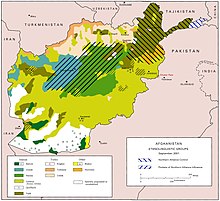
Some sources claim that Hazaras comprise about 20 to 30 percent of the total population of Afghanistan.[10][43][90][100] They were by far the largest ethnic group in the past, in 1888–1893 Uprisings of Hazaras over sixty percent of them were massacred with some being displaced and meanwhile, they also lost a large part of their territory to non-Hazaras that could double their land size today.[75]
Geographic distribution
Afghanistan
This section needs expansion. You can help by adding to itadding to it or making an edit request. (October 2023) |

The Hazaras are one of the largest ethnic groups in Afghanistan, primarily residing in the Hazaristan region in central Afghanistan and generally scattered throughout Afghanistan.[101]
Until the 1880s, the Hazaras were completely autonomous and controlled the entire Hazaristan region. Nowadays, the vast majority of Hazaras reside in Hazaristan and many others reside in the cities of the country.[citation needed]
Central Asia
After the massacre and genocide of the Hazaras by Abdur Rahman in 1888–1893, many Hazaras migrated to Central Asia regions under the occupation of Tsarist Russia, such as Uzbekistan, Tajikistan, Turkmenistan, and Kazakhstan, and some of them settled mostly in Samarkand and Bukhara. Over time, a large number of Hazaras living in the regions of Tsarist Russia lost their accent, language and ethnic identity due to the similarities of their racial structure and appearance with the people of those regions and were assimilated among them.[78][102]
Pakistan
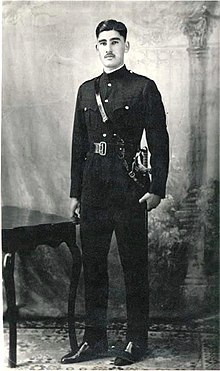
During the period of British colonial rule on the Indian subcontinent in the 19th century, Hazaras worked during the winter months in coal mines, road construction, and other working-class jobs in some cities of what is now Pakistan. The earliest record of Hazara in the areas of Pakistan is found in Broadfoot's Sappers company from 1835 in Quetta. This company had also participated in the First Anglo-Afghan War. Some Hazara also worked on the agriculture farms in Sindh and the construction of the Sukkur barrage.[citation needed] In 1962, the government of Pakistan recognized the Hazaras as one of the ethnic groups of Pakistan.[103]
Most Pakistani Hazaras today live in the in Balochistan, Pakistan. Localities in the city of Quetta with prominent Hazara populations include Hazara Town and Mehr Abad and Hazara tribes such as the Sardar are exclusively Pakistani. The literacy level among the Hazara community in Pakistan is relatively high compared to the Hazaras of Afghanistan, and they have integrated well into the social dynamics of the local society. Saira Batool, a Hazara woman, was one of the first female pilots in the Pakistan Air Force. Other notable Hazaras include Qazi Muhammad Isa, General Muhammad Musa Khan, who served as the 4th Commander-in-Chief of the Pakistan Army from 1958 to 1968, Air Marshal Sharbat Ali Changezi, whose years of service in the Pakistan Air Force were from 1949 to 1987, Hussain Ali Yousafi, the slain chairman of the Hazara Democratic Party,[104] Sayed Nasir Ali Shah, MNA from Quetta and his father Haji Sayed Hussain Hazara who was a senator and member of Pakistan Parliament during the Zia-ul-Haq era.[citation needed]
Despite all of this, Hazaras are often targeted by militant groups such as the Lashkar-e-Jhangvi and others. "Activists say at least 800-1,000 Hazaras have been killed since 1999 and the pace is quickening. More than one hundred have been murdered in and around Quetta since January, according to Human Rights Watch."[105] The political representation of the community is served by Hazara Democratic Party, a secular liberal democratic party, headed by Abdul Khaliq Hazara.[106][107]
Iran

The Hazara people in Iran are also referred to as Barbari (Persian: بربری),[108] or Khāwari (خاوری).[109] Over many years as a result of political unrest in Afghanistan, some Hazaras have migrated to Iran. The local Hazara population has been estimated at 500,000.[6] Before the separation of Afghanistan from Iran according to the Treaty of Paris in 1857 during the reign of Naser al-Din Shah, Greater Khorasan covered a part of the west of this land and various tribes or ethnic groups lived in it. One of these tribes was the Hazaras. This tribe, who settled on both sides of the border after drawing the border line between Iran and Afghanistan, has played many roles in the contemporary history of Khorasan province and especially Mashhad. The leadership of this tribe at the end of the Qajar period and also the Pahlavi period was with Muhammad Yusuf Khan Hazara known as "Sulat al-Sultanah Hazara", a Sunni Hazara who was a politician and the first Sunni representative member in the Iranian Parliament and the only Sunni Iranian who has represented Mashhad in the history of Iran's legislatures.[110][111]
India
This section needs expansion. You can help by adding to itadding to it or making an edit request. (October 2023) |
The Attarwala claim to be Hazara who mainly inhabitant in the state of Gujarat, India, descended from a group of Mughal soldiers who were initially settled in Agra, during the rule of the Mughal Emperor Jahangir.[112] According to their recorded documents, they then migrated to Ahmedabad via Gwalior, Ratlam and Godhra. This migration followed their participation in the community in the 1857 Indian War Independence. Once settled in Gujarat, India, the community took up the occupation of manufacturing perfumes known as ittars.[112] The word attarwala means the manufacturer of perfumes. A second migration took place in 1947 from Agra, after the partition of India, with some members immigrating to Pakistan, while others joining their co-ethnics in Ahmedabad.[112]
Diaspora
Alessandro Monsutti argues, in his recent anthropological book,[113] that migration is the traditional way of life of the Hazara people, referring to the seasonal and historical migrations which have never ceased and do not seem to be dictated only by emergencies such as war.[114] Due to the decades of war in Afghanistan and the sectarian violence in Pakistan, many Hazaras left their communities and have settled in Australia, New Zealand, Canada, the United States, the United Kingdom and particularly the Northern European countries such as Sweden and Denmark. Some go to these countries as exchange students while others through human smuggling, which sometimes costs them their lives. Since 2001, about 1,000 people have died in the ocean while trying to reach Australia by boats from Indonesia.[105] Many of these were Hazaras. The notable case was the Tampa affair in which a shipload of refugees, mostly Hazaras, was rescued by the Norwegian freighter MV Tampa and subsequently sent to Nauru.[115]
Culture and society
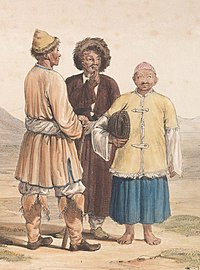
Hazara culture is a combination of customs, traditions, behaviors, beliefs and norms that have been formed in interaction and confrontation with the surrounding phenomena for many years and now it is displayed as a cultural identity. The Hazara culture is rich in heritage, with many unique cultures, and has common influences with various cultures of Central Asia and South Asia. The Hazaras, outside of Hazarajat, have adopted the cultures of the cities where they dwell, resembling the cultures and traditions of the Afghan Tajiks and Pashtuns. Traditionally the Hazara are highland farmers. In Hazarajat, they have retained many of their own cultures and traditions and many of their cultures and traditions are more closely related to those of Central Asians than to those of the Afghan Tajiks. Historically and traditionally, Hazaras live in houses, but some of them such as Aimaq Hazara and a few other are semi-nomadic and live mostly in felt yurts, rather than houses.[116][117][118]
Attire
Hazara clothing have an important and special role in supporting the cultural, traditional and social identity of the Hazara ethnicity. Hazara clothes are produced manually and by machine; In Afghanistan these types of clothes are sewn in most parts of the country, especially in central provinces of Afghanistan.[119][120]
Male clothing
Hazara men traditionally wear barak, also called barag, and hat. Barak is one of the important components of Hazara people's clothing. Barak is a kind of soft, sticky and thick piece made from the first wool of lambs of special sheep that are raised in Hazarajat, provided. In addition to being a very acceptable, stylish, and regal clothe, the Hazara barak is also a warm winter that is resistant to moisture and does not get wet easily in snow and rain. Also, barak has a special property and softness, it reduces muscle pains and is also healing for joint pains. Nowadays, the most common clothes among Hazara men is the perahan o tunban and sometimes with a hat or a turban.[119][120][121]
Female clothing
The traditional clothing of Hazara women includes a pleated skirt with a tunban or undergarment. The lower tunbans are made of fabrics such as flowered chits and the upper skirts are made of better fabrics such as velvet or zari and net and have a border or decoration at the bottom. The women's shirt is calf-length, close-collared, and long-sleeved, and has slits on both sides that are placed on the skirts, which are admired for their completeness in the Islamic set. Hazara women's clothing has certain characteristics according to their social, economic, and age conditions. The clothes of young Hazara women are made of different fabrics in different colors and happy designs with beautiful and colorful chador, but older women prefer dark-colored fabrics with simple black and white designs. Hazara women's chador or head cover is often decorated with ornaments that is often silver or gold, and sometimes with a hat. The ornaments on the clothe is silver or gold necklace with colorful beads, buttons, bangles and silver or gold bracelets.[119][120]
Headgear
Hazaras traditionally wear headgear or hats, which are of different types for men and women. There are different types of Hazara hats and caps, some of which are made from animal skin and some from barak. Also some Hazara men wear the turban of Khorasan.[122][123]
Cuisine
The Hazara cuisine is strongly influenced by Central Asian, South Asian and Persian cuisines. However, there are special foods, cooking methods and different cooking styles that are specific to them. They have a hospitable dining etiquette. In their culture, it is customary to prepare special food for guests.[citation needed]
Language
The Hazaras speak the Dari and Hazaragi dialects of the Persian language.[28][29][30][31]
The Hazara people in Hazaristan region speak the Hazaragi dialect of Persian, which is infused with many Turkic and a few Mongolic words.[29][30][100][124][125] According to Atif Adnan, the Hazara population speaks Persian with some Mongolian words.[65] The primary differences between Persian and Hazaragi are the accent.[29] Despite these differences, Hazaragi is mutually intelligible with Dari,[28] the official language of Afghanistan.[126]
According to Doctor of Sciences Lutfi Temirkhanov, the ancestors of the Hazaras were Mongol-speaking[17][49] and only after the resettlement, they mixed with the Persian-speaking and Turkic-speaking population: "hordes of Mongol princes and feudal lords found themselves in a Persian-speaking encirclement; they mixed with them, were influenced by the Persian-Tajik culture and gradually adopted the Persian language".[127] According to a number of sources, in the 16th century the Mongolian language was widespread among the Hazaras.[53][51] According to some, Turkic and Mongolic words make up about 20% of the vocabulary of Hazaragi dialect.[128]
Religion

Hazaras predominantly practice Islam, mostly the Shi'a, with a significant and almost a large Sunni, some Isma'ili and Non-denominational Islam.[12][13] The majority of Afghanistan's population practices Sunni Islam; this may have contributed to the discrimination against them.[43]
Shia Hazaras
This section needs expansion. You can help by adding to itadding to it or making an edit request. (September 2023) |
There is no single theory about the acceptance of the Shi'a Islam by the majority of Hazaras. Probably most of them accepted Shi'a Islam during the first part of the 16th century, in the early days of the Safavid dynasty.[129][12][13]
Sunni Hazaras
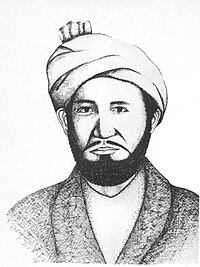
A significant and almost a large population of Hazara people are Sunni Muslims. Sunni Hazaras have been Sunni since long ago and before the occupation of Hazara lands by Abdul Rahman, but some of them were converted from Shia to Sunni Islam after the occupation of Hazara lands by Abdul Rahman and 1888–1893 Hazara uprisings. In Afghanistan, they inhabit in different provinces such as Kabul, Baghlan, Badghis, Ghor, Kunduz, Panjshir, Bamyan, Badakhshan, Parwan, and in some other regions of Afghanistan.[130][131]
A Sunni Hazara, Sher Muhammad Khan Hazara, the chieftain of the Hazaras of Qala e Naw, Badghis province and a warlord who participant in the Sunni coalition that defended Herat in 1837. Also, one of the defeaters of British forces around Qandahar and Maiwand desert during the First Anglo-Afghan War in 1838–1842.[132]
Isma'ili Hazaras
Isma'ili Hazaras mainly live in provinces of Kabul, Parwan, Baghlan and Bamyan. And their smaller groups live in Maidan Wardak, Samangan, Zabul, and... The Isma'ili Hazaras have always been kept separate from the rest of the Hazaras on account of religious beliefs and political purposes.[133]
Hazara tribes
The Hazara people have been organized by various tribes. Some overarching Hazara tribes are Sheikh Ali, Jaghori, Jaghatu, Qara Baghi, Ghaznichi, Muhammad Khwaja, Behsudi, Daimirdadi, Turkmani, Uruzgani, Daikundi, Daizangi, Daichopan, Daizinyat, Naiman, Qarlugh, Aimaq Hazara, and others.[134] The different tribes come from Hazaristan (Hazara regions), such as Parwan, Bamyan, Ghazni, Ghor, Uruzgan, Daikundi, Maidan Wardak, and... have spread outwards from Hazaristan (main region) in other parts of Afghanistan, and also in other Hazara-populated areas.
Art


Writers and poets
Some well-known Hazara writers and poets include Faiz Muhammad Kateb, Amir Khosrow Dehlavi, Ismael Balkhi, Hassan Poladi, Kazim Yazdani, Ali Mohaqiq Nasab, Kamran Mir Hazar, Basir Ahang, Sayed Askar Mousavi, Ali Baba Taj, Sayed Abutalib Mozaffari, Rahnaward Zaryab, Aziz Royesh and so on.
Music
Many Hazara musicians are widely hailed as being skilled in playing the dambura, a native, regional lute instrument similarly found in other Central Asian nations, such as Kazakhstan, Uzbekistan and Tajikistan. Some of the famous Hazara musician and dambura players are, such as Sarwar Sarkhosh, Dawood Sarkhosh, Safdar Tawakoli, Sayed Anwar Azad and others.[116] In Hazara dambura sometimes revolutionary hymns are very common. The first singer who started singing revolutionary hymns on dambura was Sarwar Sarkhosh, and his main message was the uprising of the young generation and the fight against oppression.[135] Also Ghaychak a field instruments in music that is usually played like a fiddle. The resonance bowl is made of walnuts or berries and its wires are metal which is one of the stringed instruments in Hazara music.[136]
Cinema
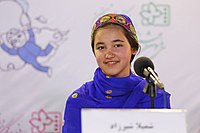
Hazara cinema artists have no older background, but nowadays some of their famous actors and actresses include Hussain Sadiqi, Abid Ali Nazish, Shamila Shirzad, Nikbakht Noruz and others.
Sports


Many Hazaras engaged in varieties of sports, including football, volleyball, wrestling, martial arts, boxing, karate, taekwondo, judo, wushu, Jujitsu, Cricket, Tennis, and more. Pahlawan Ebrahim Khedri, a 62 kg wrestler, was the national champion for two decades in Afghanistan. Another famous Hazara wrestler, Wakil Hussain Allahdad, was killed in the 22 April 2018 Kabul suicide bombing in Dashte Barchi, Kabul.[137][138]
Rohullah Nikpai, won a bronze medal in Taekwondo at the Beijing Olympics 2008, beating world champion Juan Antonio Ramos of Spain 4–1 in a play-off final. It was Afghanistan's first-ever Olympic medal. He then won a second Olympic medal for Afghanistan in the London 2012 games.[citation needed]
Another notable Hazara athlete Sayed Abdul Jalil Waiz was the first ever badminton player representing Afghanistan in the Asian Junior Championships in 2005, where he produced the first win for his country against Iraq, with 15–13, 15–1. He participated in several international championships since 2005 and achieved victories against Australia, the Philippines and Mongolia. Hamid Rahimi, a Hazara boxer from Afghanistan who lives in Germany. Hussain Sadiqi, a Hazara Australian martial artist who won an award for the best fight scene for an Australian made action movie.
Hazara football players are Zohib Islam Amiri, who is currently playing for the Afghanistan national football team, Moshtaq Yaqoubi an Afghan-Finnish footballer who plays for HIFK, Mustafa Amini, a Hazara Australian footballer who plays as a midfielder for Danish Superliga club AGF and the Australian national team, Rahmat Akbari an Australian footballer who plays as a midfielder for Brisbane Roar, and others like Rohullah Iqbalzada, Omran Haydary, Zelfy Nazary, Moshtaq Ahmadi, and Zahra Mahmoodi.[139]
Some Hazara from Pakistan have also excelled in sports and have received numerous awards, particularly in boxing, football and field hockey.
Pakistani Hazara Abrar Hussain, a former Olympic boxer served as deputy director-general of the Pakistan Sports Board. He represented Pakistan three times at the Olympics and won a gold medal at the 1990 Asian Games in Beijing. Another Hazara boxer from Pakistan is Haider Ali a Commonwealth Games gold medalist and Olympian who is currently retired.
Former captain of the Pakistan national football team Qayyum Changezi was the second Pakistani footballer to score a hat trick in an international game. [140][141][142] New Hazara youngsters are seen to appear in football in Pakistan mostly from Quetta, such as Muhammad Ali and Rajab Ali Hazara.[143]
Another is Kulsoom Hazara, a Pakistani female karate champion who has won several gold, silver and bronze medals on national and international stages, including Pride of Pakistan Award.[144] Other karateka Hazaras include Nargis Hameedullah who became the first Pakistani woman to win an individual medal (a bronze) at the Asian Games karate championship, and Shahida Abbasi.[citation needed]
Cultural sports
Cultural sports of Hazara people are those sports that have been inherited from their ancestors for generations.
Buzkashi

Buzkashi is a Central Asian sport in which horse-mounted players attempt to place a goat or calf carcass in a goal. It is the national sport in Afghanistan and is one of the cultural sports of the Hazara people and they still practice this sport in Afghanistan.[145]
Tirandāzi
Tirandāzi is a kind of archery and an old cultural sport of Hazaras.[146]
Pahlawani
Pahlawani or Kushti is a kind of cultural wrestling sport that is performed by Hazaras. Pahlawani has a long history in Afghanistan and among the Hazaras. In Afghanistan, on holidays, Pahlawani fields are set up. Pahlawani is held in different age groups. This cultural sport has its special techniques. Because this sport is very ancient and familiar, it has been continued from generation to generation among the Hazaras.[147]
Notable people
Gallery
- Flags
- Pictures
-
Hazara men in the uniform of the National Army of Afghanistan
-
Hazara young men in Kabul
-
An elderly Hazara man
-
Alauddini Hazaras in Ghazni province
-
Hazara men on the anniversary of the death of Abdul Ali Mazari in Kabul
-
Hazara schoolboys
- Cultural
-
Hazara girls from Ghazni province
-
Hazara boy in cultural clothing with a dambura
- Historical
-
An 1879 portrait of a Daizangi Hazara man
-
Mir Muhammad Azim Beig, a populous and powerful Hazara chieftain in the 1880s
See also
| Part of a series on |
| Hazaras |
|---|
 |
|
|
|
References
- ^ "سرور دانش درصد جمعیت شیعه و هزاره را در گزارش دولت آمریکا نادرست خواند". BBC News فارسی (in Persian). Retrieved 2023-01-08.
- ^ Garrison, V. David. "Global Peoples Profiles:: Hazara of Afghanistan and Deccanis of India". www.missionfrontiers.org. Retrieved 2024-01-08.
- ^ Siddique, Abubakar (21 February 2013). "Hazaras of Pakistan". Radio Free Europe/Radio Liberty. Retrieved 22 Dec 2022.
- ^ Census of Afghans in Pakistan 2005, UNHCR Statistical Summary Report (retrieved August 14, 2016)
- ^ a b Yusuf, Imran (5 October 2011). "Who are the Hazara?". Tribune. Retrieved 1 September 2016.
- ^ a b c Smyth, Phillip (3 June 2014). "Iran's Afghan Shiite Fighters in Syria". The Washington Institute for Near East Policy. Retrieved 22 June 2017.
- ^ "Austria holds refugee talks as young Hazaras flee persecution to make 'dangerous' journey to Europe – ABC News (Australian Broadcasting Corporation)". mobile.abc.net.au. 2016-02-29. Retrieved 2017-08-19.
- ^ "Cultural Diversity". Australian Bureau of Statistics. 2021-08-10. Retrieved 2022-06-28.
- ^ "Afghan Hazara Refugees Seek Justice in Turkey". 3 June 2014.
- ^ a b The population of people with descent from Afghanistan in Canada is 48,090. Hazara make up an estimated 30% of the population of Afghanistan depending to the source. The Hazara population in Canada is estimated from these two figures. Ethnic origins, 2006 counts, for Canada Archived 2018-12-24 at the Wayback Machine
- ^ Afghan Hazaras' new life in Indonesia: Asylum-seeker community in West Java is large enough to easily man an eight-team Afghan football league, Al Jazeera, 21 March 2014, retrieved 5 August 2016
- ^ a b c The Afghans, Their History and Culture, Religion Archived 2010-12-28 at the Wayback Machine
- ^ a b c "شناسنامه الکترونیکی،آخرین فرصت تثبیت هویت هزارههای سنی و اسماعیلی | سایت طرح نو، باشگاه اندیشه و گفتوگو". Retrieved 2021-02-02.
- ^ Brasher, Ryan (2011). "Ethnic Brother or Artificial Namesake? The Construction of Tajik Identity in Afghanistan and Tajikistan". Berkeley Journal of Sociology. 55: 97–120. JSTOR 23345249.
- ^ B. Campbell, Disappearing people? Indigenous groups and ethnic minorities in South and Central Asia in: Barbara Brower, Barbara Rose Johnston (Ed.) International Mountain Society, California, 2007.
- ^ "Sunni Hazaras of Afghanistan". September 17, 2020.
- ^ a b c d Temirkhanov L. (1968). "О некоторых спорных вопросах этнической истории хазарейского народа". Советская этнография. 1. P. 86. In Russian: "...монгольские отряды, оставленные в Афганистане Чингиз-ханом или его преемниками, стали исходным пластом, основой хазарейского этногенеза. "
- ^ a b Bacon, Elizabeth Emaline (1951). The Hazara Mongols of Afghanistan: A Study in Social Organization. Berkeley: University of California.
- ^ a b دلجو, عباس. تاریخ باستانی هزارهها. کابل، افغانستان: موسسه انتشارات مقصوی، کابل. pp. 37, 167, 257. ISBN 978-9936-624-00-9.
- ^ a b Babur, (Emperor of Hindustan) (1826). Memoirs of Zehir-Ed-Din Muhammed Baber: Emperor of Hindustan. Longman, Rees, Orme, Brown, and Green.
- ^ a b c d Martínez-Cruz, Begoña; Vitalis, Renaud; Ségurel, Laure; Austerlitz, Frédéric; Georges, Myriam; Théry, Sylvain; Quintana-Murci, Lluis; Hegay, Tatyana; Aldashev, Almaz; Nasyrova, Firuza; Heyer, Evelyne (2011). "In the heartland of Eurasia: the multilocus genetic landscape of Central Asian populations". European Journal of Human Genetics. 19 (2): 216–223. doi:10.1038/ejhg.2010.153. ISSN 1476-5438. PMC 3025785. PMID 20823912.
- ^ Dupree, L. (2006). "AFGHANISTAN" [iv. Ethnography]. Encyclopædia Iranica (Online ed.).
- ^ "Afghanistan: 31,822,848 (July 2014 est.) @ 9% (2014)". The World Factbook. Central Intelligence Agency. Retrieved July 17, 2015.
- ^ Hyder, Kamal (November 12, 2011). "Hazara community finds safe haven in Peshawar". Al Jazeera English. Retrieved November 12, 2011.
- ^ "COUNTRY PROFILE: AFGHANISTAN" (PDF). Library of Congress Country Studies. Retrieved August 22, 2017.
- ^ "Shi'a and Hazaras". Minority Rights Group. 2018-06-14. Retrieved 2023-02-07.
- ^ Malik Ayub Sumbal. "The Plight of the Hazaras in Pakistan". The Diplomat. Retrieved August 22, 2017.
- ^ a b c "Attitudes towards Hazaragi". pp. 1–2. Retrieved June 5, 2014.
- ^ a b c d Kieffer, Charles M. "HAZĀRA" [iv. Hazāragi dialect]. Encyclopædia Iranica. Retrieved August 22, 2017.
- ^ a b c d Monsutti, Alessandro (2017-07-01), "Hazāras", Encyclopaedia of Islam, THREE, Brill, retrieved 2022-05-07
- ^ a b c d Bosworth, C. E. (2012-04-24), "Hazāras", Encyclopaedia of Islam, Second Edition, Brill, retrieved 2022-05-08
- ^ Emadi, Hafizullah (September 1997). "The Hazaras and their role in the process of political transformation in Afghanistan". Central Asian Survey. 16 (3): 363–387. doi:10.1080/02634939708400997.
Hazaras are one of the oppressed and dispossessed national minority communities of the country.
- ^ Alessandro Monsutti (15 December 2003). "HAZĀRA ii. HISTORY". Encyclopædia Iranica. Retrieved 16 December 2012.
- ^ Mousavi, S. A. (2018). The Hazaras of Afghanistan. Routledge. ISBN 978-1-136-80016-0.
- ^ Babur, Z. M. (1987). Babur-nama. Lahore. pp. 300, 207, 214, 218, 221, 251–53.
{{cite book}}: CS1 maint: location missing publisher (link) - ^ Babur, Zahīr ud-Dīn Muhammad (1826). Memoirs of Zehir-Ed-Din Muhammed Baber: Emperor of Hindustan. Longman, Rees, Orme, Brown, and Green.
- ^ یزدانی، حسینعلی. پژوهشی در تاریخ هزارهها. چاپخانه مهتاب. ص 96
- ^ "هزاله – لغتنامهٔ دهخدا" [Dehkhoda Dictionary]. abadis.ir. Retrieved 2022-01-07.
- ^ "هزاره".
- ^ Schurmann, H. F. (1962). The Mon-gols of Afghanistan: An Ethnography of the Moghôls and Related Peoples of Afghanistan. La Haye. p. 115.
- ^ Poladi, Hassan (1989). The Hazâras. Stockton. p. 22.
- ^ Mousavi, Sayed Askar (1998). The Hazaras of Afghanistan [An Historical, Cultural, Economic and Political Study]. Richmond. pp. 23–25.
- ^ a b c Khazeni, Arash; Monsutti, Alessandro; Kieffer, Charles M. (December 15, 2003). "HAZĀRA". Encyclopædia Iranica (Online ed.). United States. Retrieved December 23, 2007.
{{cite encyclopedia}}: CS1 maint: location missing publisher (link) - ^ دلجو, عباس. تاریخ باستانی هزارهها. کابل، افغانستان: موسسه انتشارات مقصوی، کابل. p. 199. ISBN 978-9936-624-00-9.
- ^ "HAZĀRA ii. HISTORY – Encyclopaedia Iranica". Iranicaonline.org. Retrieved 2021-03-12.
- ^ Hartl, Daniel L.; Jones, Elizabeth W. (2009). Genetics: Analysis of Genes and Genomes. Jones & Bartlett Learning. p. 262. ISBN 978-0-7637-5868-4.
- ^ دلجو, عباس. تاریخ باستانی هزارهها. کابل، افغانستان: موسسه انتشارات مقصوی، کابل. p. 257. ISBN 978-9936-624-00-9.
- ^ B. Campbell, Disappearing people? Indigenous groups and ethnic minorities in South and Central Asia in Barbara Brower, Barbara Rose Johnston (Ed.) International Mountain Society, California, 2007
- ^ a b Temirkhanov L. (1968). "О некоторых спорных вопросах этнической истории хазарейского народа". Советская этнография. 1. P. 91. In Russian: "Об участии монголов в этногенезе хазарейцев свидетельствуют и данные лингвистики... также исторические источники (например, «Записки Бабура») и данные топонимики"
- ^ Sabitov Zh. M. (2011)."Происхождение хазарейцев с точки зрения ДНК-генеалогии". The Russian Journal of Genetic Genealogy. 2 (1): pp. 37–40.
- ^ a b Бартольд. В. В. (2022). Ислам. Культура мусульманства. Москва: Litres. p. 162. In Russian: "...еще в XVI веке говорили хазарейцы по-монгольски в северной части Афганистана..."
- ^ Ármin Vámbéry (2003). Путешествие по Средней Азии. Москва: Восточная литература. In Russian: "Говорят, что хазарейцы ... были перевезены Чингисханом из Монголии, своей прародины, на юг Средней Азии и благодаря влиянию шаха Аббаса II обращены в шиизм. Поразительно, что они заменили свой родной язык персидским, который даже в населенных ими областях не повсеместно распространен, и лишь небольшая часть, оставшаяся изолированной в горах поблизости от Герата и уже несколько столетий занимающаяся выжиганием угля, говорит на некоем жаргоне монгольского языка."
- ^ a b Массон В. М., Ромодин В. А. (1964). История Афганистана. Том I. С древнейших времен до начала XVI века. Москва: Наука. pp. 289–290. In Russian: "Еще в XVI в., по сообщению Бабура, среди хазарейцев был распространен монгольский язык, а небольшая часть их, по-видимому, и в XIX в. говорила на языке, близком к монгольскому."
- ^ Петрушевский И. П. (1952). Рашид-ад-дин и его исторический труд. Москва/Ленинград: Издательство Академии Наук СССР. P. 29. In Russian: "Как известно, большой массив монгольского населения (хезарейцы), отчасти сохранявшего свой язык еще в XIX в., сложился на территории Афганистана..."
- ^ Allah Rakha, Fatima, Min-Sheng Peng, Atif Adan, Rui Bi, Memona Yasmin, Yong-Gang Yao (2017)."mtDNA sequence diversity of Hazara ethnic group from Pakistan". Forensic Science International: Genetics. Volume 30: Pages e1-e5. In English: "Moreover, there are also lines of evidence that some of the remote tribes of Hazaras spoke Mongol language till last century. Their central Asian facial features including sparse beards, high cheekbones and epicanthic eye folds further supports their Mongol origin."
- ^ Haber, M; Platt, DE; Ashrafian Bonab, M; et al. (2012). "Afghanistan's Ethnic Groups Share a Y-Chromosomal Heritage Structured by Historical Events". PLOS ONE. 7 (3): e34288. Bibcode:2012PLoSO...734288H. doi:10.1371/journal.pone.0034288. PMC 3314501. PMID 22470552.
- ^ Rosenberg, Noah A.; et al. (December 2002). "Genetic Structure of Human Populations". Science. New Series. 298 (5602): 2381–85. Bibcode:2002Sci...298.2381R. doi:10.1126/science.1078311. PMID 12493913. S2CID 8127224.
- ^ Martínez-Cruz, Begoña; Vitalis, Renaud; Ségurel, Laure; Austerlitz, Frédéric; Georges, Myriam; Théry, Sylvain; Quintana-Murci, Lluis; Hegay, Tatyana; Aldashev, Almaz; Nasyrova, Firuza; Heyer, Evelyne (2011). "In the heartland of Eurasia: the multilocus genetic landscape of Central Asian populations". European Journal of Human Genetics. 19 (2): 216–223. doi:10.1038/ejhg.2010.153. ISSN 1476-5438. PMC 3025785. PMID 20823912.
Our study confirms the results of Li et al's study that cluster the Hazara population with Central Asian populations, rather than Mongolian populations, which is consistent with ethnological studies. Our results further extend these findings, as we show that the Hazaras are closer to Turkic-speaking populations from Central Asia than to East-Asian or Indo-Iranian populations.
- ^ He, Guanglin; Adnan, Atif; Rakha, Allah; Yeh, Hui-Yuan; Wang, Mengge; Zou, Xing; Guo, Jianxin; Rehman, Muhammad; Fawad, Abulhasan; Chen, Pengyu; Wang, Chuan-Chao (September 2019). "A comprehensive exploration of the genetic legacy and forensic features of Afghanistan and Pakistan Mongolian-descent Hazara". Forensic Science International: Genetics. 42: e1–e12. doi:10.1016/j.fsigen.2019.06.018. ISSN 1872-4973. PMID 31257046. S2CID 195761020.
The results from pairwise genetic distances, MDS, PCA, and phylogenetic relationship reconstruction demonstrate that present-day Hazaras are genetically closer to the Turkic-speaking populations (Uyghur, Kazakh, and Kyrgyz) residing in northwest China than with other Central/South Asian populations and Mongolian. Outgroup and admixture f3, f4, f4-ratio, qpWave, and qpAdm results further demonstrate that Hazara shares more alleles with East Asians than with other Central Asians and carries 57.8% Mongolian-related ancestry. Overall, our findings suggest that Hazaras have experienced genetic admixture with the local or neighboring populations and formed the current East-West Eurasian admixed genetic profile.
- ^ Chen, Pengyu; Adnan, Atif; Rakha, Allah; Wang, Mengge; Zou, Xing; Mo, Xiaodan; He, Guanglin (2019-08-18). "Population background exploration and genetic distribution analysis of Pakistan Hazara via 23 autosomal STRs". Annals of Human Biology. 46 (6): 514–518. doi:10.1080/03014460.2019.1673483. ISSN 0301-4460. PMID 31559868. S2CID 203569169.
Overall, we genotyped 25 forensic-related markers in 261 Quetta Hazara individuals and provided the first batch of 23-autosomal STRs for forensic genetics and population genetics research. 23-autosomal STRs included in Huaxia Platinum were polymorphic in the Hazara population and could be used as powerful tool for forensic investigations. Population genetic comparisons based on two datasets via PCA, MDS and phylogenetic relationship reconstruction consistently indicated that the Quetta Hazara in Pakistan shared significant genetic components with Central Asians, especially for Turkic-speaking populations.
- ^ Xu, Shuhua; Wang, Sijia; Tang, Kun; Guan, Yaqun; Khan, Asifullah; Li, Jing; Zhang, Xi; Wang, Xiaoji; Tian, Lei (2017-10-01). "Genetic History of Xinjiang's Uyghurs Suggests Bronze Age Multiple-Way Contacts in Eurasia". Molecular Biology and Evolution. 34 (10): 2572–2582. doi:10.1093/molbev/msx177. ISSN 0737-4038. PMID 28595347.
- ^ Haber, Marc; Platt, Daniel E.; Bonab, Maziar Ashrafian; Youhanna, Sonia C.; Soria-Hernanz, David F.; Martínez-Cruz, Begoña; Douaihy, Bouchra; Ghassibe-Sabbagh, Michella; Rafatpanah, Hoshang; Ghanbari, Mohsen; Whale, John; Balanovsky, Oleg; Wells, R. Spencer; Comas, David; Tyler-Smith, Chris; Zalloua, Pierre A.; Consortium, The Genographic (28 March 2012). "Afghanistan's Ethnic Groups Share a Y-Chromosomal Heritage Structured by Historical Events". PLOS ONE. 7 (3): e34288. Bibcode:2012PLoSO...734288H. doi:10.1371/journal.pone.0034288. PMC 3314501. PMID 22470552.
- ^ John William Whale. Mitochondrial DNA Analysis of Four Ethnic Groups of Afghanistan. http://eprints.port.ac.uk/9862/1/John_Whale_MPhil_Thesis_2012.pdf Archived 2017-08-02 at the Wayback Machine
- ^ Lkhagvasuren, Gavaachimed; Shin, Heejin; Lee, Si Eun; Tumen, Dashtseveg; Kim, Jae-Hyun; Kim, Kyung-Yong; Kim, Kijeong; Park, Ae Ja; Lee, Ho Woon; Kim, Mi Jin; Choi, Jaesung; Choi, Jee-Hye; Min, Na Young; Lee, Kwang-Ho (14 September 2016). "Molecular Genealogy of a Mongol Queen's Family and Her Possible Kinship with Genghis Khan". PLOS ONE. 11 (9): e0161622. Bibcode:2016PLoSO..1161622L. doi:10.1371/journal.pone.0161622. PMC 5023095. PMID 27627454. "Eastern Russian Tatars, Bashkirs, and Pakistani Hazara were found to carry R1b-M343 at unusually high frequencies of 12.65%, 46.07%, and 32%, respectively, compared to other regions of Eastern Asia, which rarely have this haplotype"
- ^ a b Adnan, Atif; Wen, Shao-Qing; Rakha, Allah; Alghafri, Rashed; Nazir, Shahid; Rehman, Muhammad; Wang, Chuan-Chao; Lu, Jie (2020). "Forensic features and genetic legacy of the Baloch population of Pakistan and the Hazara population across Durand-line revealed by y chromosomal STRS". doi:10.1101/2020.11.21.392456. S2CID 227172830.
{{cite journal}}: Cite journal requires|journal=(help) - ^ Allah Rakha, Fatima, Min-Sheng Peng, Atif Adan, Rui Bi, Memona Yasmin, Yong-Gang Yao (2017)."mtDNA sequence diversity of Hazara ethnic group from Pakistan". Forensic Science International: Genetics. Volume 30: Page 3.
- ^ Quintana-Murci, L; Chaix, R; Wells, RS; et al. (May 2004). "Where West Meets East: The Complex mtDNA Landscape of the Southwest and Central Asian Corridor". The American Journal of Human Genetics. 74 (5): 827–45. doi:10.1086/383236. PMC 1181978. PMID 15077202.
- ^ "MtDNA sequence diversity of Hazara ethnic group from Pakistan". Retrieved 2021-03-12.
- ^ Quintana-Murci, L; Chaix, R; Wells, RS; et al. (May 2004). "Figure 1: Where west meets east: the complex mtDNA landscape of the southwest and Central Asian corridor". Am. J. Hum. Genet. 74 (5): 827–45. doi:10.1086/383236. PMC 1181978. PMID 15077202.
- ^ a b c d e "HAZĀRA: ii. HISTORY". Alessandro Monsutti (Online ed.). United States: Encyclopædia Iranica. December 15, 2003. Retrieved 9 August 2012.
- ^ Sarabi, Humayun (2005). "Politics and Modern History of Hazara" [Sectarian Politics in Afghanistan]. Fletcher School of Law and Diplomacy. Archived from the original on 2011-09-18. Retrieved 2011-11-02.
- ^ "Ahmad Shah and the Durrani Empire". Library of Congress Country Studies on Afghanistan. 1997. Retrieved 2010-08-25.
- ^ "THE AMEER CAPTURES URZAGHAN". The New York Times. 1892-10-02. ISSN 0362-4331. Retrieved 2022-08-21.
- ^ Mousavi, Sayed Askar (1998). The Hazaras of Afghanistan : an historical, cultural, economic and political study. Richmond, Surrey: Curzon. ISBN 978-1-315-02693-0. OCLC 1100424512.
- ^ a b دلجو, عباس. تاریخ باستانی هزارهها. کابل: انتشارات امیری. ISBN 978-9936801509.
- ^ کاتب, فیضمحمد (1913). سراجالتواریخ. کابل: مطبعه دارالسلطنته.
- ^ Zamani, Ezzatullah (September 2019). "The 'Genocide of the Hazaras' in Afghanistan from 1884 to 1905 and subsequent genocidal campaigns and target killings against them in the 21st century". Genocide of the Hazaras of Afghanistan.
- ^ a b "کوچ اجباری و اثرات فرهنگی واجتماعی آن بر جامعه هزاره". archive.mashal.org. Retrieved 2022-08-31.
- ^ Runion, Meredith L. (2017). The History of Afghanistan, 2nd edition. ABC-CLIO-LLC. p. 124. ISBN 978-1-61069-778-1.
- ^ Dorronsoro, Gilles (2005). Revolution Unending: Afghanistan, 1979 to the Present. London: Hurst & Company. p. 104. ISBN 1-85065-703-3.
- ^ Rashid, Ahmed (March 1, 2001). Taliban: Militant Islam, Oil and Fundamentalism in Central Asia (Paperback ed.). New Haven, CT: Yale University Press. ISBN 978-0-300-08902-8.
- ^ Ahmed Rashid, Taliban: Militant Islam, Oil, and Fundamentalism in Central Asia, London and New Haven, 2000, p. 58
- ^ Ahmed Rashid, Taliban: Militant Islam, Oil, and Fundamentalism in Central Asia, London and New Haven, 2000, pp. 67–74
- ^ "Taliban blow apart 2,000 years of Buddhist history". The Guardian. 3 March 2001.
- ^ "Who is Justice Qazi Faez Isa?". DAWN.COM. June 19, 2020.
- ^ "Qazi Muhammad Isa and the reference against Justice Qazi Faez Isa". June 14, 2020.
- ^ Fida Yunas, S. (2008). Pg 33. Sultan Ali Kishtmand had remained Prime Minister of Afghanistan from 10 January 1981 to 26 May 1990, with a brief break of about nine months, when Dr Hassan Sharq replaced him from 20 June 1988 to .... Retrieved 2012-07-30.
- ^ Williams, Brian Glyn (2011-09-22). Afghanistan Declassified: A Guide to America's Longest War – Brian Glyn Williams – Google Books. University of Pennsylvania Press. ISBN 978-0-8122-0615-9. Retrieved 2012-07-30.
- ^ "Afghanistan: massacres of Hazaras". Human Rights Watch. February 2001. Retrieved December 27, 2007.
- ^ a b Larson, Marisa (June 17, 2008). "Hazara People". National Geographic. Archived from the original on March 2, 2008. Retrieved August 9, 2012.
- ^ Sappenfield, Mark (August 6, 2007). "Afghanistan's success story: The liberated Hazara minority". Christian Science Monitor. Retrieved December 27, 2007.
- ^ "Many Karzai rivals find way to Parliament". Pajhwok.com. 2011-01-22. Archived from the original on 2012-03-13. Retrieved 2012-07-30.
- ^ "(27 February 2012) Afghanistan set to host second national ski race. wanderlust.co.uk". Wanderlust.co.uk. Archived from the original on 4 August 2017. Retrieved 30 October 2017.
- ^ Levinson, Charles (March 7, 2012). "Since Skiing Came to Afghanistan, It Has Been Pretty Much All Downhill". Wall Street Journal.
- ^ a b "Afghan nomad clashes raise fears of ethnic strife". Bangkok Post. AFP. 7 August 2012.
- ^ "Afghan Overture to Taliban Aggravates Ethnic Tensions". The New York Times, 27 June 2010.
- ^ "Afghanistan's minority Hazaras see gains of past two decades 'falling apart'". France 24. 23 August 2021. Retrieved 31 August 2021.
- ^ Mogul, Rhea (29 August 2021). "Afghanistan's religious minorities live in fear of Taliban, brace for persecution". NBC News. Retrieved 31 August 2021.
- ^ Anonym. ""The people will fight the Taliban" | tellerreport.com". www.tellerreport.com. Retrieved 2021-09-03.
- ^ a b "AFGHANISTAN iv. Ethnography". L. Dupree (Online ed.). United States: Encyclopædia Iranica. December 15, 1983.
- ^ Dames, M. Longworth (2012-04-24), "Hazāra", Encyclopaedia of Islam, First Edition (1913–1936), Brill, retrieved 2023-08-09
- ^ موسوی, سید عسکر. هزارههای افغانستان. pp. 204–205.
- ^ پولادی, حسن (1387). هزارهها.
- ^ "Hussain Ali Yousafi, chairman of the Hazara Democratic Party'", BBC News, 26 January 2009
- ^ a b Bigg, Matthew (2012-10-25). "Insight: Pakistani death squads spur desperate voyage to Australia". Reuters. Retrieved 8 December 2013.
- ^ "Balochistan's Hazaras speak out — Qurat ul ain Siddiqui interviews Secretary-General of the Hazara Democratic Party, Abdul Khaliq Hazara". Dawn.com. Retrieved 2012-07-30.
- ^ "List of Political parties". Hazarapress.com. Retrieved 2012-07-30.
- ^ Ed (2012-04-24), "Berberi", Encyclopaedia of Islam, Second Edition, Brill, retrieved 2023-08-13
- ^ اینترنشنال, هزاره (2014-05-11). "ایل هزاره در خراسان و فرهنگ جعلی جلیل آریایی". هزاره اینترنشنال (in Persian). Retrieved 2023-08-13.
- ^ ""«شورش خراسان» در کتابفروشیها شکل میگیرد"" (PDF). Archived from the original (PDF) on 2018-05-17. Retrieved 2022-12-29.
- ^ بیات, کاوه (2016). شورش خراسان و صولتالسلطنه هزاره (زمستان 1320). موسسه فرهنگی هنری جهان کتاب. ISBN 978-6006732688.
- ^ a b c Mohideen, AM (2003). "Attarwalla". In Singh, KS (ed.). Gujarat. People of India Part One. Vol. XXI. Popular Prakashan. pp. 78–81. ISBN 9788179911044.
- ^ Monsutti, Alessandro (2005). War and migration: Social networks and economic strategies of the Hazaras of Afghanistan. New York: Routledge. ISBN 978-0-415-97508-7.
- ^ Monsutti, Alessandro (2005). War and migration: Social networks and economic strategies of the Hazaras of Afghanistan. Translated by Patrick Camiller. Routledge, New York: Routledge. ISBN 978-0-415-97508-7.
- ^ Australia ships out Afghan refugees BBC News.
- ^ a b Latham, Robert Gordon (1859). Eastern and northern Asia Europe. J. van Voorst. p. 333. Retrieved 2013-12-08.
- ^ افغانستان, روزنامه. "استقبال گسترده از روز فرهنگ هزارگی در کشور – روزنامه افغانستان". www.dailyafghanistan.com (in Persian). Retrieved 2022-09-10.
- ^ Spuler, B. (2012-04-24), "Aymak", Encyclopaedia of Islam, Second Edition, Brill, retrieved 2023-08-15
- ^ a b c tebyan.net, موسسه فرهنگی واطلاع رسانی تبیان | (2017-06-09). "لباس های سنتی زنان و مردان هزاره". fa. Retrieved 2022-08-28.
- ^ a b c "Clothing of the Hazāra Tribes". Encyclopædia Iranica. Retrieved 31 August 2022.
- ^ "Barak". Encyclopaedia Iranica. Retrieved 31 August 2022.
- ^ Foundation, Encyclopaedia Iranica. "Clothing of the Hazāra tribes". iranicaonline.org. Retrieved 2023-09-24.
- ^ tebyan.net, موسسه فرهنگی واطلاع رسانی تبیان | (2017-06-09). "لباس های سنتی زنان و مردان هزاره". fa (in Persian). Retrieved 2023-09-24.
- ^ Malistani, A. H. Tariq and Gehring, Roman (compilers) (1993) Farhang-i ibtidal-i milli-i Hazarah : bi-inzimam-i tarjamah bih Farsi-i Ingilisi = Hazaragi – Dari/Persian- English: a preliminary glossary A. H. Tariq Malistani, Quetta, OCLC 33814814
- ^ Farhadi, A. G. Ravan (1955). Le persan parlé en Afghanistan: Grammaire du kâboli accompagnée d'un recuil de quatrains populaires de la région de Kâbol. Paris.
- ^ "Languages in Afghanistan". The Swedish Committee for Afghanistan (SCA). Retrieved 2021-02-14.
- ^ Temirkhanov L. (1968). "О некоторых спорных вопросах этнической истории хазарейского народа". Советская этнография. 1. P. 93-94. In Russian: "орды монгольских царевичей и феодалов оказались в таджикском окружении; они смешивались с таджиками, подвергались влиянию персидско-таджикской культуры и постепенно принимали язык таджиков, отсюда и таджикская речь хазарейцев".
- ^ خاوری, محمد جواد. امثال و حِکم مردم هزاره. مشهد: نشر عرفان. p. 16.
- ^ Dorronsoro, Gilles (2005). Revolution unending: Afghanistan, 1979 to the present, By Gilles Dorronsoro, pg.44. C. Hurst. ISBN 978-1-85065-703-3. Retrieved 2012-07-30.
- ^ پولادی, حسن (1387). هزارهها: تاریخ، سیاست، اقتصاد و فرهنگ. ترجمهٔ علی عالمی کرمانی. انتشارات عرفان. pp. 205–206. ISBN 978--964-06-0527-1.
- ^ گیزابی, محمداکرم (1375). هزارهها و هزارستان اثر گروه تحقیقی پیدی میتلند. ترجمهٔ محمداکرم گیزابی. مجمع نویسندگان افغانستان. p. 192.
- ^ دلجو, عباس. تاریخ باستانی هزارهها. کابل، افغانستان: موسسه انتشارات مقصوی، کابل. p. 222. ISBN 978-9936-624-00-9.
- ^ خواتی, شفق (1382). مجله طلوع. pp. 52–68.
- ^ Hazara tribal structure, Program for Culture and Conflict Studies, US Naval Postgraduate School
- ^ "The Hazara Nationalism: in Music and Historical Literature". 24 December 2014.
- ^ "قیچک – لغتنامه دهخدا [Dehkhoda Dictionary]".
- ^ Nordland, Rod; Faizi, Fatima (September 20, 2018). "'Suicider!' Came the Warning. For Afghans, Wrestlers' Deaths Resound. (Published 2018)". The New York Times. Archived from the original on 2022-01-03 – via NYTimes.com.
- ^ Mashal, Mujib (2018-04-23). "After Each Attack He Carried the Wounded. Then He Became a Victim. (Published 2018)". The New York Times. ISSN 0362-4331. Archived from the original on 2022-01-03. Retrieved 2020-12-03.
- ^ "Islam Amiri Hazara – Afghan national football team captain and Fans "player of the year"". Hazara.net. 24 September 2013. Retrieved May 25, 2014.
- ^ Hyat, Kamila (2014-06-29). "The years of dreams | Special Report | thenews.com.pk". www.thenews.com.pk. Retrieved 2023-08-15.
- ^ Ahsan, Ali (2010-12-23). "A history of football in Pakistan — Part I". DAWN.COM. Retrieved 2023-07-21.
- ^ Editorial Staff (2011-05-20). "Lahore Free Kick contest named after Qayyum Ali Changezi". FootballPakistan.com (FPDC). Retrieved 2023-08-15.
- ^ "Rajab Ali Hazara to lead under 16 Pakistan Football team as captain". www.hazara.net. 2013-09-24. Retrieved 2014-09-18.
- ^ Adil, Hafsa. "'Role model': Pakistan's Hazara woman packing a punch". www.aljazeera.com. Retrieved 2023-02-10.
- ^ YJC, خبرگزاری باشگاه خبرنگاران | آخرین اخبار ایران و جهان | (9 May 2017). "تاریخچه ورزش "بزکشی" در افغانستان + تصاویر" [History of "Buzkashi" sport in Afghanistan + Pictures]. fa (in Persian). Retrieved 2021-09-13.
- ^ "مسابقات تیراندازی با کمان در بامیان، میدان و غزنی" (in Persian). Retrieved 2022-09-09.
- ^ "کشتی محلی افغانستان؛ ورزشی پرهیجان با علاقمندان فراوان+تصاویر". af.shafaqna.com. Retrieved 2022-09-10.
Further reading
- Monsutti, Alessandro (2005). War and migration: Social networks and economic strategies of the Hazaras of Afghanistan. Translated by Patrick Camiller. Routledge, New York: Routledge. ISBN 978-0-415-97508-7.
- Mousavi, S. A. (2018). The Hazaras of Afghanistan. Routledge. ISBN 978-1-136-80016-0.
- Frederiksen, Birthe; Nicolaisen, Ida (1996). Caravans and trade in Afghanistan: The changing life of the nomadic Hazarbuz. Carlsberg Foundation's Nomad Research Project. London: Thames and Hudson. ISBN 978-0-500-01687-9.
- Poladi, Hassan (1989). The Hazāras. Stockton, California: Mughal Publishing Company. ISBN 978-0-929824-00-0.
- Kakar, M. Hasan (1973). The pacification of the Hazaras of Afghanistan. New York: Afghanistan Council, Asia Society. OCLC 1111643.
- Harpviken, Kristian Berg (1996). Political Mobilization Among the Hazara of Afghanistan: 1978–1992 (PDF). Rapportserien ved Sosiologi, Nr. 9 1996. Oslo: Institutt for Sosiologi, Universitetet i Oslo. ISBN 978-82-570-0127-8. Archived from the original (PDF) on 2011-09-27. Retrieved 2011-04-27.
External links
- "Hazaras" at Encyclopædia Iranica
- Hazara tribal structure, Program for Culture and Conflict Studies, US Naval Postgraduate School
- Peril and Persecution in Afghanistan




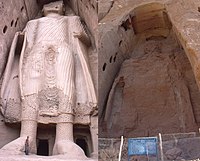

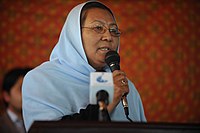

![Abbas Noyan is a politician, who served as a member of the Afghanistan Parliament, representative of the people of Kabul province from 2005 to 2010. He is the former Afghanistan's ambassador to Sweden.[99]](http://upload.wikimedia.org/wikipedia/commons/thumb/6/6c/Abbas_Noyan_in_Kabul_in_2018.jpg/200px-Abbas_Noyan_in_Kabul_in_2018.jpg)
